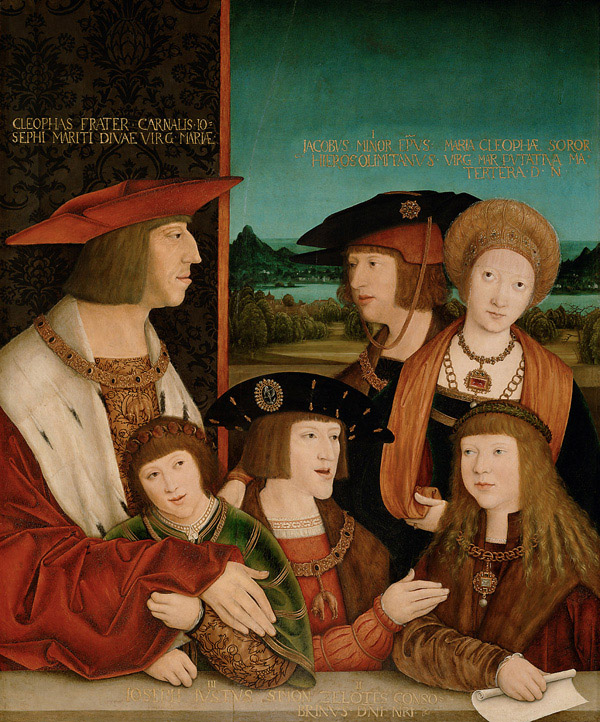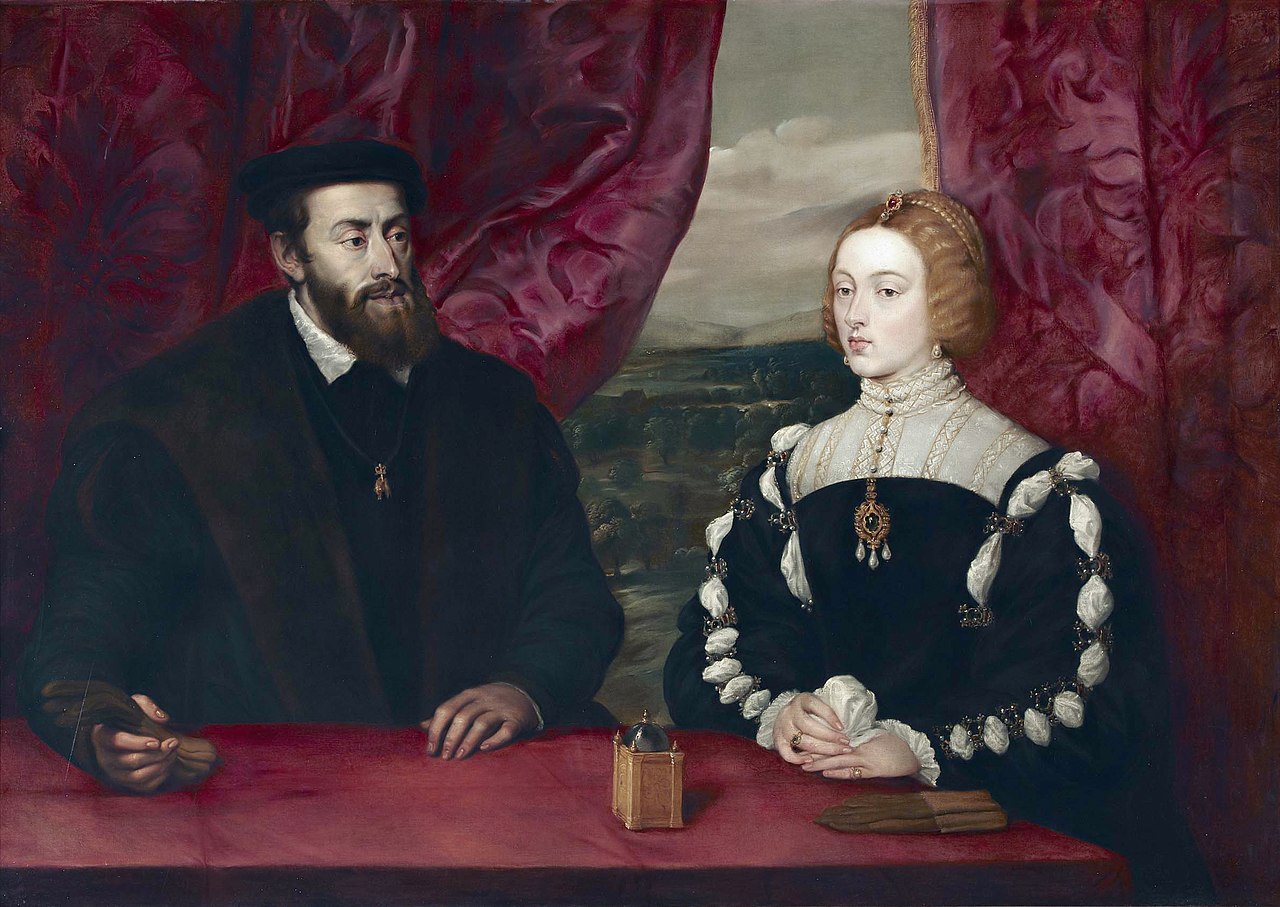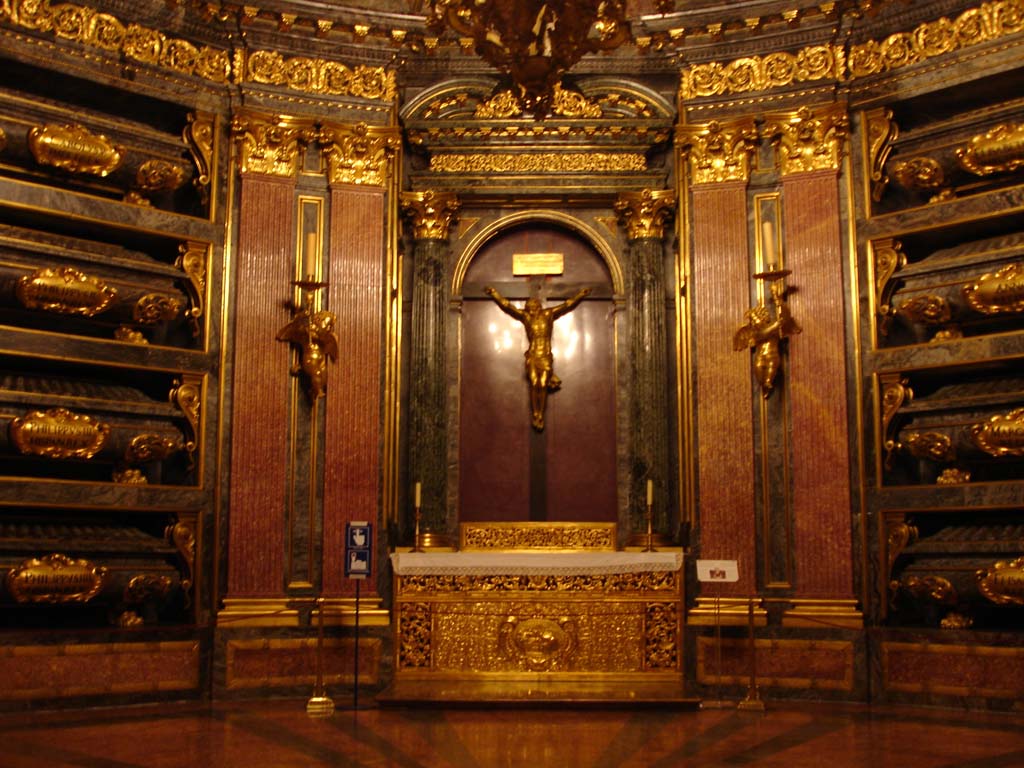by Susan Flantzer
© Unofficial Royalty 2022

Charles V, Holy Roman Emperor, King of Spain, Archduke of Austria, Lord of the Netherlands, Duke of Burgundy; Credit – Wikipedia
The Holy Roman Empire was a limited elective monarchy composed of hundreds of kingdoms, principalities, duchies, counties, prince-bishoprics, and Free Imperial Cities in central Europe. The Holy Roman Empire was not really holy since, after Holy Roman Emperor Charles V in 1530, no emperors were crowned by the pope or a bishop. It was not Roman but rather German because it was mainly in the regions of present-day Germany and Austria. It was an empire in name only – the territories it covered were mostly independent each with its own rulers. The Holy Roman Emperor directly ruled over only his family territories, and could not issue decrees and rule autonomously over the Holy Roman Empire. A Holy Roman Emperor was only as strong as his army and alliances, including marriage alliances, made him, and his power was severely restricted by the many sovereigns of the constituent monarchies of the Holy Roman Empire. From the 13th century, prince-electors, or electors for short, elected the Holy Roman Emperor from among the sovereigns of the constituent states.
Frequently but not always, it was common practice to elect the deceased Holy Roman Emperor’s heir. The Holy Roman Empire was an elective monarchy. No person had a legal right to the succession simply because he was related to the current Holy Roman Emperor. However, the Holy Roman Emperor could and often did, while still alive, have a relative (usually a son) elected to succeed him after his death. This elected heir apparent used the title King of the Romans.
Learn more at Unofficial Royalty: What was the Holy Roman Empire?
********************
Best known as Charles V, Holy Roman Emperor, Charles was one of the most powerful ever monarchs and had a large number of titles due to his vast inheritance of the Burgundian, Spanish, and Austrian realms. He was born on February 24, 1500, at the Prinsenhof in Ghent, County of Flanders, Burgundian State, now in Belgium. He was the second of the six children and the elder of the two sons of Philip of Austria, Duke of Burgundy, the ruler of the Burgundian State from the House of Habsburg, and Juana I, Queen of Castile and León from the House of Trastámara.

A portrait of the extended Habsburg family: standing (left to right) Maximilian I. Holy Roman Emperor; Maximilian and Mary’s son Philip of Austria; Maximilian’s first wife Mary of Burgundy; sitting (left to right) Maximilian and Mary’s grandsons Ferdinand I, Holy Roman Emperor and Charles V, Holy Roman Emperor; and Louis II, King of Hungary, Croatia and Bohemia, the husband of Maximilian and Mary’s granddaughter Mary of Austria; (Note: This portrait is anachronistic. Mary of Burgundy died in 1482 when her son Philip of Austria was 4 years old and her son Philip died in 1506 when his son Charles was 6 years old); by Bernhard Strigel painted after 1515; Credit – Wikipedia
Charles’ paternal grandparents were Maximilian I, Holy Roman Emperor and the ruler of the Archduchy of Austria, and the Duchies of Styria, Carinthia, and Carniola, and the first of his three wives, Mary, Duchess of Burgundy, the ruler of the Burgundian State in her own right. His maternal grandparents were Ferdinand II, King of Aragon and Isabella I, Queen of Castile and León. Charles would turn out to be the heir to all four of his grandparents’ dominions.

The three eldest children of Philip and Juana: Eleanor, Charles, and Isabella; Credit – Wikipedia
Charles had five younger siblings who were all monarchs or consorts of monarchs:
- Eleanor of Austria, Queen of Portugal, Queen of France (1498 – 1558), married (1) Manuel I, King of Portugal (his third wife), had two children (2) François I, King of France (his second wife), no children
- Isabella of Austria, Queen of Denmark, Norway, and Sweden (1501 – 1526), married Christian II, King of Denmark, Norway, and Sweden, had five children, only two daughters survived childhood
- Ferdinand I, Holy Roman Emperor, (1503 – 1564), married Anna of Bohemia and Hungary, had fifteen children
- Mary of Austria, Queen of Bohemia and Hungary, Governor of the Spanish Netherlands (1505 – 1558), married Louis II, King of Hungary, Croatia and Bohemia, no children
- Catherine of Austria, Queen of Portugal (1507 – 1578), married João III, King of Portugal, had nine children
Four years after his birth, Charles’ maternal grandmother Isabella I, Queen of Castile and León died. His mother Juana became Queen of Castile and León but her father Ferdinand II, King of Aragon proclaimed himself Governor and Administrator of Castile and León. In 1506, Juana’s husband Philip became King of Castile and León jure uxoris (by the right of his wife) as Philip I, initiating the rule of the Habsburgs in the Spanish kingdoms which would last until 1700 when the Spanish branch of the House of Habsburg became extinct. However, Philip’s rule lasted only from July 12, 1506 to September 25, 1506, when he died, aged 28, apparently of typhoid fever, although an assassination by poisoning was rumored at the time.
Philip had spread rumors about Juana’s supposed madness and her misunderstood behavior after his death may have reinforced these rumors. Juana decided to transfer Philip’s remains from Burgos in the north of present-day Spain, where he had died and had already been buried, to Granada in the south of present-day Spain, a journey that took eight months. This trip was used as evidence of Juana’s madness. Juana did show excessive grief as she traveled through Castile with Philip’s coffin. What is overlooked is that her 28-year-old husband died suddenly after a five-day illness and that Juana was fulfilling Philip’s wish to be buried in Granada. In addition, her father Ferdinand deliberately blocked Philip’s burial in Granada causing major delays in Juana’s journey.

Charles in 1519; Credit – Wikipedia
As can be seen in the above portrait, Charles suffered from an enlarged lower jaw, often called the Habsburg jaw, a congenital deformity that became considerably worse in later Habsburg generations. The deformity was probably caused by the family’s long history of inbreeding, commonly practiced in royal families of that time to maintain dynastic control of territories.
In 1509, Juana’s father Ferdinand II, King of Aragon convinced the parliament that Juana was too mentally ill to govern and was appointed her guardian and the regent of Castile and León. Juana was confined in the Royal Convent of Santa Clara in Tordesillas, Castile, now in Spain, under the orders of her father. In 1516, Ferdinand II, King of Aragon died. In his will, Ferdinand named his daughter Juana and her eldest son Charles the co-heirs of the Kingdom of Aragon. However, Juana would never reign as her son Charles would continue keeping her confined. Juana would not be released from her confinement until she died in 1555. Was Juana mad or was she manipulated by her father, her husband, and her son? Juana’s father Ferdinand and her son Charles had much to gain from Juana being declared unfit to rule and confined.

Territories controlled by the 19-year-old Charles in 1519; Credit – by Lucio Silla, modification by Paul2, recreated by Schoeneh – Modification of Europa02.jpg, using Europe-central-blank.svgEste archivo deriva de: Empire-Roman-Emperor-Charles-V.jpg de original author, CC BY-SA 4.0, https://commons.wikimedia.org/w/index.php?curid=106952839
Charles would inherit and reign over the dominions of his mother Juana (Castile and León, and Aragon which would be united under Charles as the Kingdom of Spain), the dominions of his father Philip (the Burgundian State Philip had inherited from his mother Mary, Duchess of Burgundy, consisting of parts of the present-day Netherlands, Belgium, Luxembourg, France, and Germany), and also the Habsburg dominions of his paternal grandfather Maximilian (Archduchy of Austria, Duchy of Styria, Duchy of Carinthia, and Duchy of Carniola, today parts of Austria and Slovenia). Charles would be elected Holy Roman Emperor after the death of his paternal grandfather Maximilian in 1519. In addition, Charles oversaw the continuation of the Spanish colonization of the Americas.
Charles’ Titles
- Titular Duke of Burgundy as Charles II
- Duke of Brabant as Charles II
- Duke of Limburg as Charles II
- Duke of Lothier as Charles II
- Duke of Luxemburg as Charles III
- Margrave of Namur as Charles II
- Count Palatine of Burgundy as Charles II
- Count of Artois as Charles II
- Count of Charolais as Charles II
- Count of Flanders as Charles III
- Count of Hainault as Charles II
- Count of Holland as Charles II
- Count of Zeeland as Charles II
- King of Castile and León as Carlos I
- King of Aragon and Sicily as Carlos I
- Count of Barcelona as Carlos I
- King of Naples as Carlo IV
- Archduke of Austria as Karl I
- Holy Roman Emperor as Charles V
- Count of Zutphen
- Duke of Guelders as Charles III

Portrait of Isabella of Portugal by Titian; Credit – Wikipedia
On March 11, 1526, at the Royal Alcázar of Seville in Seville, Spain, Charles married his first cousin Isabella of Portugal, daughter of Manuel I, King of Portugal and his second wife Maria of Aragon, daughter of Ferdinand II, King of Aragon and Isabella I, Queen of Castile and León. Charles and Isabella’s main residence was in Spain. Charles was often away from his family to lead military campaigns and administer his other realms, and Isabella was appointed regent in his absence.

Charles and his son and successor Felipe; Credit – Wikipedia
Charles and Isabella had five children but only three survived to adulthood:
- Felipe II, King of Spain (1527 – 1598), married (1) his double first cousin Maria Manuela, Infanta of Portugal who died giving birth to a son who predeceased his father (2) his first cousin once removed Queen Mary I of England, no children (3) Elisabeth of Valois, had five pregnancies but only two surviving daughters, Elisabeth died a few hours after the loss of her last child (4) his niece Anna of Austria had five children but only one son Felipe III, King of Spain survived childhood, Anna died of heart failure eight months after giving birth to her last child
- Maria of Austria (1528 – 1603), married her first cousin Maximilian II, Holy Roman Emperor, had sixteen children
- Ferdinand of Austria (1529 – 1530), died in infancy
- Juana of Austria (1535 – 1573), married her first cousin João Manuel, Hereditary Prince of Portugal, had one son Sebastian, King of Portugal
- Juan of Austria (1537 – 1538), died in infancy

Double portrait of Charles and Isabella by Peter Paul Rubens after a portrait by Titian; Credit – Wikipedia
Charles and Isabella’s happy marriage lasted for thirteen years. In 1539, during the third month of Isabella’s seventh pregnancy, she developed a fever causing her to miscarry. The fever caused her condition to worsen and Isabella died two weeks later on May 1, 1539, aged thirty-five. Charles was so grief-stricken that he shut himself up in a monastery for two months where he prayed and mourned for her in solitude. He never recovered from Isabella’s death, dressed in black for the rest of his life, and despite being only thirty-nine, never remarried.

Titian’s La Gloria, one of the several paintings commissioned by Charles V in memory of his wife Isabella; On the right are Charles, his wife Isabella, his son Felipe, his daughter Juana, and his sisters Mary and Eleanor, all wearing their shrouds Credit – Wikipedia
In memory of Isabella, Charles commissioned several musical and artistic tributes to Isabella. Probably his favorite tributes were the portraits of Isabella that he commissioned from his favorite painter Tiziano Vecelli, better known as Titian. Titian painted several portraits of Isabella, which included his Portrait of Isabella of Portugal (the portrait of Isabella above in this article), La Gloria (directly above, read about the painting at the link), and a double portrait of Isabella and Charles (above). Charles kept these paintings with him whenever he traveled and after he retired to the Monastery of Yuste.

Charles several years before his abdication; Credit – Wikipedia
Physically exhausted after forty years of ruling, Charles abdicated in 1555, the same year his 75-year-old mother Juana, confined for forty-six years, died. Charles retired to the peace of the Monastery of Yuste in Extremadura, Spain. He suffered from epilepsy and had a serious case of gout. As he aged, his gout progressed from painful to crippling. In his retirement, Charles was carried around the monastery in a sedan chair. A ramp was specially constructed to allow him easy access to his rooms.

Charles’ bedroom at the Monastery of Yuste; Credit – By Alonso de Mendoza – Own work, CC BY-SA 4.0, https://commons.wikimedia.org/w/index.php?curid=78867364
Upon Charles’s abdication, his younger brother Ferdinand, who had already been given Charles’ Austrian lands in 1521, became the Holy Roman Emperor. The Spanish Empire, including the possessions in the Netherlands and Italy, was inherited by Charles’ son who reigned as Felipe II, King of Spain. In addition, Felipe II also added the Kingdom of Portugal to the House of Habsburg’s dominions. In 1578, King Sebastian of Portugal from the House of Aviz was killed in battle without any heirs, causing a succession crisis. He was succeeded by his elderly great-uncle Henrique who was a Cardinal of the Roman Catholic Church and had no descendants because he had taken a vow of chastity as a priest. When Cardinal-King Enrique died two years later, three grandchildren of Manuel I, King of Portugal claimed the Portuguese throne. Ultimately, the grandchild who was successful in his claim was Felipe II, King of Spain. The Iberian Union was the union of the Kingdom of Spain and the Kingdom of Portugal that existed between 1580 and 1640, under the Spanish Habsburg kings Felipe II, Felipe III, and Felipe IV who reigned in Portugal under the names Filipe I, Filipe II, and Filipe III. In 1640, the Portuguese House of Braganza came to power in Portugal after deposing the Spanish Habsburgs in the Portuguese Restoration War.
In August 1558, Charles became seriously ill with malaria. He died, aged fifty-eight, at the Monastery of Yuste on September 21, 1558, holding the same cross his wife Isabella had been holding when she died. Charles was originally buried in the chapel at the Monastery of Yuste. However, in his will, he asked for the establishment of a new religious site where he could be reburied with his beloved wife Isabella.

Royal Site of San Lorenzo de El Escorial; Credit – By Turismo Madrid Consorcio Turístico from Madrid, España – Monasterio EscorialUploaded by Ecemaml, CC BY 2.0, https://commons.wikimedia.org/w/index.php?curid=6581920
To fulfill his father’s wish, in 1563, Charles’s son King Felipe II of Spain started building the Royal Site of San Lorenzo de El Escorial, located in the town of San Lorenzo de El Escorial about 28 miles/45 kilometers from Madrid, Spain. The complex includes a palace, basilica, monastery, and library. When the Royal Crypt was completed in 1574, the remains of Charles and Isabella were re-interred in a small vault directly underneath the altar of the Royal Chapel. In 1654, after the basilica and royal tombs were finally completed during the reign of their great-grandson Felipe IV, King of Spain, the remains of Charles and Isabella were moved into the Royal Pantheon of Kings. Since then, the Royal Site of San Lorenzo de El Escorial has been the burial place of Spanish monarchs and many members of the Spanish royal family.

The Royal Pantheon of Kings where Charles and his wife Isabella are interred; Credit – Wikipedia
This article is the intellectual property of Unofficial Royalty and is NOT TO BE COPIED, EDITED, OR POSTED IN ANY FORM ON ANOTHER WEBSITE under any circumstances. It is permissible to use a link that directs to Unofficial Royalty.
Works Cited
- En.wikipedia.org. 2022. Charles V, Holy Roman Emperor – Wikipedia. [online] Available at: <https://en.wikipedia.org/wiki/Charles_V,_Holy_Roman_Emperor> [Accessed 21 July 2022].
- Es.wikipedia.org. 2022. Carlos I de España – Wikipedia, la enciclopedia libre. [online] Available at: <https://es.wikipedia.org/wiki/Carlos_I_de_Espa%C3%B1a> [Accessed 21 July 2022].
- Flantzer, Susan, 2022. Juana I, Queen of Castile and León and Queen of Aragon. [online] Unofficial Royalty. Available at: <https://www.unofficialroyalty.com/juana-i-queen-of-castile-and-leon-and-queen-of-aragon/> [Accessed 21 July 2022].
- Flantzer, Susan, 2022. Philip of Austria, Duke of Burgundy, King of Castile and León. [online] Unofficial Royalty. Available at: <https://www.unofficialroyalty.com/philip-of-austria-duke-of-burgundy-king-of-castile/> [Accessed 21 July 2022].
- Wilson, Peter, 2016. Heart of Europe: A History of the Holy Roman Empire. Cambridge: Harvard University Press.
